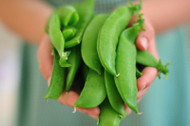Harvesting and storing peas.
If the peas are allowed to ripen on the vine, even one, it can trigger the pea plant to stop flowering and then you're done, it's all over. Picking once or twice a week is recommended to get the maximum out of your vines so even if get completely fed up with peas keep at it, you can always store them for winter use.
Storing Peas If, like me, you have a number of pea vines and they are producing faster than you can eat them you'll need to look at picking them for storage. Blanching is important when freezing fresh vegetables if you don't want to be disappointed when the time comes to eat them. Please see explanation below:
Blanching Vegetables The most popular method of storing vegetables is to freeze them and if you are going to do this it's very important to blanch them. If you don't do this the enzymes present in the vegetables will cause them to loose colour and flavour after 4 to 6 weeks in the freezer. Enzymes are catalysts meaning they speed up chemical reactions and are responsible for ripening fruit as well as causing it to rot. Essentially we are going to 'turn off' these guys to ensure the frozen food stays as fresh as possible. Enzymes are deactivated by high temperatures so we drop the vegetables very briefly in boiling water and then cool them quickly to stop them cooking, see below:
To 'Blanch' first make sure you have a copious supply of ice cubes as you need to stop the cooking process quickly.
Method: Bring a pan of water to a rolling boil making sure you have enough water to cover the vegetables you want to blanch. Different vegetable require different blanching times due to their size. Under blanching is actually worse than not blanching at all as it stimulates the enzymes rather than knocking them out. Over do it and you loose vitamins and colour so a bit of a balancing act I'm afraid! I include a rough guide below:
Beans - 3 mins. Beetroot - Needs to be cooked through. Broccoli - 3 mins. Carrots (diced) - 2 mns. Cauliflower - 3 mins. Leafy Greens (Cabbage, Kale etc... shredded) - 1.5 mins. Peas - 2 mins. Turnips or Parsnips - 2 mins.
Place the vegetables in the vigourously boiling water and when the water returns to boiling point start your clock. The pan should return to the boil in a minute, any longer and you're using to much vegetables to the amount of water in the pot. Boil for the required time and remove quickly to a large bowl (I use the sink) of iced water to stop the cooking process. Vegetables take about the same amount of time to cool as they did to heat. If you are doing a number of batches of vegetables keep adding more ice to keep the water really cold.
To store place in freezer bags. A good trick is to put a straw in the bag to suck out any excess air as you seal it. Drain the vegetables well after cooling as extra moisture can effect the quality of the produce when freezing.
I know this sounds like a lot of work but it isn't really and is actually very satisfying, make like a squirrel and store up for the winter, you'll be glad you did!

